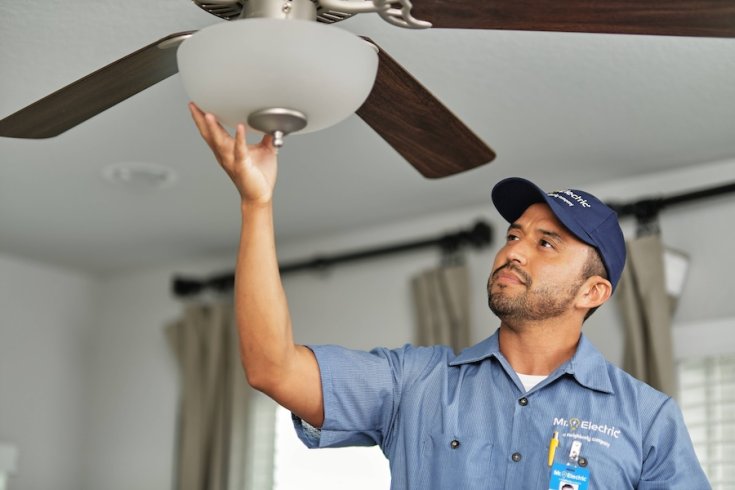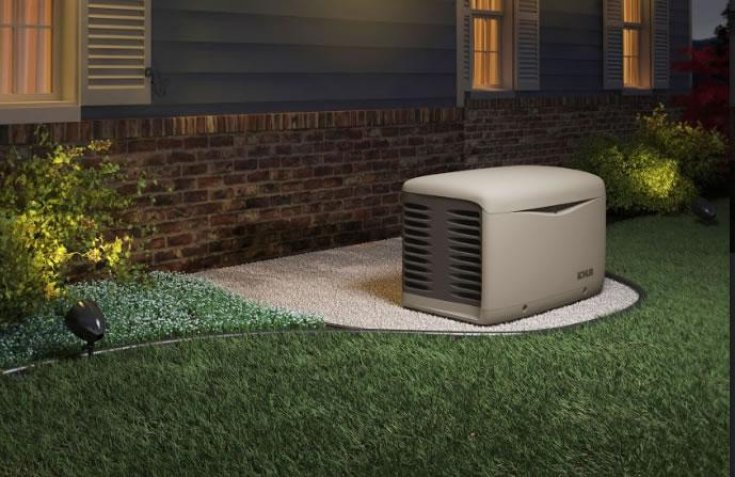A ceiling fan moves air, eases the load on your heating and cooling system, and keeps rooms comfortable without driving up utility costs. But fans don’t last forever. Motors wear down, bearings loosen, and wiring weakens. Homeowners usually ignore the warning signs and hope that a simple fix will keep the fan running. At Mr. Electric, we see this all the time, and the truth is that there comes a point when repair is no longer worth the trouble. Knowing the signals helps you avoid wasted effort and possible hazards. Scheduling a ceiling fan replacement at the right time saves money, reduces frustration, and keeps your home safe. Here are five signs to watch for so you know when to act.
1. Wobbling or Shaking That Won’t Stop
Fans are meant to run steadily. A little movement at the highest setting is normal, but a constant shake or wobble means there’s a problem. Sometimes this comes from loose mounting screws or a bracket that isn’t level. In other cases, one or more blades are warped from humidity or age. You can try tightening connections, balancing the blades, or checking that the fan is properly anchored. If you’ve done all that and it still wobbles, the motor may be deteriorating, or the housing could be warped. Why does this matter? It puts stress on the mounting hardware and electrical box. That stress can pull the fan away from the ceiling and make the wiring connections unstable, which is a serious safety risk. A shaky fan also doesn’t circulate air evenly, which defeats its purpose. Once wobbling becomes the norm instead of the exception, replacement is safer than another round of tinkering.
2. Loud Noises From the Motor
When a fan is working properly, the sound is barely noticeable. Maybe a low hum, but nothing more. Grinding, squealing, rattling, or buzzing noises usually mean that something inside is failing. Bearings wear down with age, lubrication dries out, and electrical components loosen. The motor then strains to keep the blades spinning, and you hear the result. Noise from a fan isn’t something to brush off. That grinding sound is metal wearing against metal, which only gets worse the longer it runs. Many older fans were built to last, but still can’t be serviced once the sealed motor starts to fail. Some people try to ignore the noise, but it becomes distracting in living rooms, bedrooms, and offices. Instead of tolerating the clatter, it makes sense to upgrade to a new fan. A modern unit will run quietly and deliver better airflow, which lowers irritation as well as energy costs.
3. Inconsistent Speeds or Failing Controls
A ceiling fan should respond immediately to your input. Pull the chain, flip the wall switch, or press a remote button, and the blades should spin at the selected speed. When fans only work on one setting, stall when you try to go faster, or stop responding altogether, the internal components are breaking down. The most common culprit is a failing capacitor. This small part regulates the current and keeps the motor running at the chosen speed. When it goes bad, the fan becomes unpredictable. Sometimes the light kit starts flickering as well, which signals electrical issues inside the housing. At this stage, calling professional electricians is the right move. They can confirm whether the capacitor or wiring is at fault, and normally, the recommendation is to replace the entire fan. While an individual repair might restore temporary function, a fan showing multiple control issues usually won’t last much longer.
4. Outdated or Inefficient Design
Ceiling fans have come a long way in design and efficiency. Older models use more power, generate less airflow, and come with light kits that rely on incandescent bulbs. If your fan has been in place for ten years or more, it makes sense to compare it with today’s models. Modern fans often include Energy Star ratings, redesigned blade angles that push air more effectively, and LED lighting that outlasts standard bulbs by years. Style should not be overlooked either. A fan that has yellowed or warped over time can drag down the appearance of an otherwise attractive room. Since fans are mounted overhead, they’re one of the first things people notice when entering a space. If your fan looks dated or doesn’t fit with your current décor, it might be lowering the appeal of your home without you realizing it. Ceiling fan replacement in Highlands Ranch will modernize a room while improving comfort and cutting back on utility costs.
5. Frequent Electrical Issues
The most serious warning sign is electrical trouble. If your fan trips the breaker, gives off a burning smell, or leaves scorch marks around the housing, stop using it immediately. When a fan shows flickering lights, overheats, or shuts down unexpectedly, the cause is usually loose wiring, worn connections, or overheating components inside the unit. Since fans use a good deal of power, a wiring problem can pose a fire hazard. Homeowners sometimes assume it is just a bulb or a switch, but repeated issues point to something more serious. This is the time to invest in an electrical service rather than pushing the fan until it fails. A qualified technician can check connections, run circuit tests, and confirm whether the trouble comes from the house wiring or the fan itself. In many cases, replacement ends up being the safest and smartest choice.
Why Replacement Makes Sense
Some people hesitate to replace a fan that still spins, but the costs of holding on can add up. A weak motor burns more electricity. Poor balance strains the ceiling box. Frequent flickering or noise interrupts daily life. A fan that underperforms isn’t doing its job, and eventually it becomes a safety issue. Installing a new fan gives you the benefit of updated technology and quieter performance. The energy savings alone justify the cost. Plus, modern fans add value to your home by improving comfort and appearance. Choosing replacement before the old one fails completely means you’re making the decision on your terms instead of rushing after a breakdown.
Do You Need an Electrical Repair or Ceiling Fan Upgrade?
Wobbling blades, loud motors, failing speed controls, outdated design, and electrical hazards are clear signs that it’s time for a change. Replacing a failing fan protects your home and can lower monthly energy bills. When the time comes, rely on professional electricians who know how to install safely and handle any electrical repair that might be needed along the way. At Mr. Electric, we provide dependable electrical service, from troubleshooting to complete installations, so you can enjoy a safe and comfortable home. If your ceiling fan shows any of the warning signs above, don’t wait for a failure. Call today to schedule an appointment.








